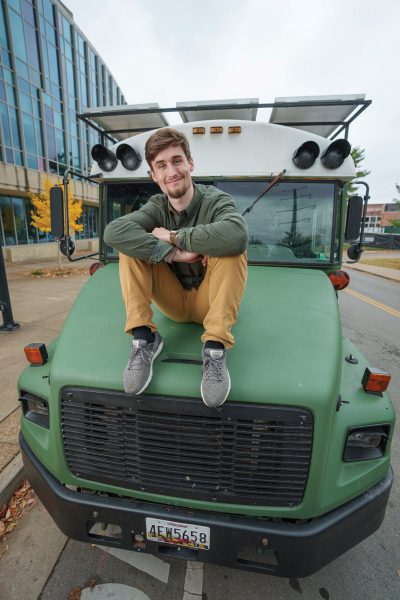By Clay Skipper, BA’12
Before arriving at Vanderbilt for his first year, Logan Glazier achieved an important life milestone: He bought a car. Well, a school bus, to be more precise. It was headed for a scrapyard after making stops at a school, a daycare, a camp and, finally, Facebook Marketplace, where Glazier found it. One $3,400 Venmo charge later—and one long car ride back and forth between his home in Maryland to the bus in New Jersey—and the 30-foot, 10,000-pound vehicle was his. He planned to turn it into an RV or a tiny home, joining a growing movement of people who are repurposing school buses into mobile living quarters. “Skoolies,” they’re called. Only he wanted to take a slightly different approach. “I hadn’t seen anyone focusing on the sustainability side of it,” he says.

He got to work. He studied solar power for months before making the decision to buy and mount an 800-watt solar panel kit on the roof. When the bus is parked, it can run entirely on green energy. He rescued as many supplies as he could from construction project leftovers—materials that otherwise would have gone to a landfill.
Then he ran into a problem. He wanted to add a roof rack to hold gear, but there was a lot to figure out: How much weight could the bus bear? How many steel supports was he going to need? What size steel should he use? Luckily, he’d landed in the exact place to answer those questions: the Vanderbilt School of Engineering, where he was working toward a major in civil engineering with a concentration in structures. He used what he was learning in class to answer his questions about the roof rack.
“It’s really empowering,” says the 20-year-old junior. “It’s easy to write classwork off as some pointless math on paper, but then you put it into practice and actually see that, wow, I know this is going to support the amount of weight I need because I’ve done the math and used all the knowledge in class to put it into reality.”
Glazier’s experience is what many educators might call the ideal result of education: the ability to take what’s learned in a classroom—be it something specific, like how to build a roof rack, or general, like critical thinking skills—and apply it in the outside world. That ideal is exactly why, when Vanderbilt rolled out a strategic plan in fall 2014, it put a greater focus on experiential learning. That plan emerged as Immersion Vanderbilt.
Glazier sees a through-line from his time at Vanderbilt working on the bus to his future professional ambitions.
He remembers asking himself at the beginning of the project: “How can I make this [bus] something that uses renewable energy and all of my engineering knowledge, put it into action here, and have this hands-on experience to try and build something I’m proud of that uses all of these sustainable aspects that I want to incorporate in work later in life?” He also credits the bus with being a stepping stone toward his future by helping him land last summer’s internship: working with an engineering company to design superstructures for bridges.
“I didn’t get many questions about coursework or the other things I advertised when I was applying for an internship,” he says. “The Vanderbilt Fusion Project [which he was a part of] and the bus were the two most-asked-about things, because they’re unique. [Employers] are curious to ask about the problems you encountered and how you overcame them.”
The engineering company has invited Glazier to join them again this summer, so he’ll be back in Madison, Wisconsin, using what he learned at Vanderbilt, and through his immersion project, to keep growing as an engineer. How does he plan to get there? His bus, of course. “Some of the friends that I have there are keeping a driveway spot open for me,” he says.